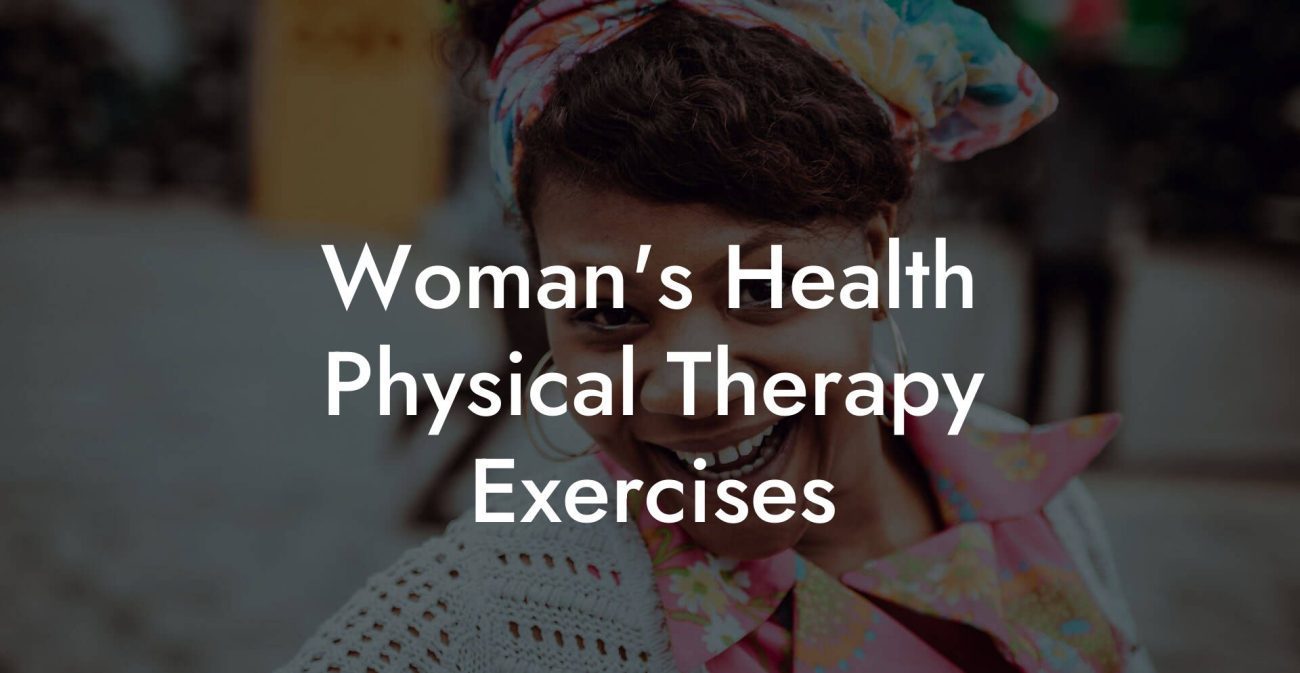
Pelvic Floor Therapy
Pelvic Organ Prolapse Exercises To Avoid

When it comes to pelvic organ prolapse, not all exercises are created equal, and some might even be sabotaging your pelvic floor health. Whether you’re a gym aficionado, a weekend warrior, or just beginning your journey into fitness, it’s crucial to know which moves could be more harm than help. This guide dives deep into the world of pelvic organ prolapse exercises to avoid, cutting through the noise with humor, honesty, and a whole lot of science-backed insights designed for Gen-Z and millennial readers.
Quick Links to Useful Sections
- Understanding Pelvic Organ Prolapse and Your Pelvic Floor
- Your Pelvic Floor: The Unsung Hero of Core Stability
- Exercises That May Worsen Pelvic Organ Prolapse
- High-Impact Cardio and Jumping Jacks
- Heavy Lifting and Overhead Presses
- Abdominal Crunches and Sit-Ups
- Deep Squats and Lunges with Heavy Weights
- High-Intensity Interval Training (HIIT) with Inadequate Core Support
- Exercises with Poor Breathing Techniques
- Why These Exercises Pose a Risk
- Safer Alternatives and Modifications for a Healthy Pelvic Floor
- Low-Impact Cardio Options
- Modified Strength Training
- Gentle Core Workouts
- Focused Breathing and Mind-Body Techniques
- Common Mistakes and Misconceptions About Pelvic Floor Exercises
- Myth 1: “More Is Always Better”
- Myth 2: “All Core Workouts Strengthen the Pelvic Floor”
- Myth 3: “You Can Fix Prolapse Solely With Exercise”
- Myth 4: “Pain Means It’s Time to Stop”
- Expert Insights: What Pelvic Floor Therapists Recommend
- Integrative and Holistic Approaches to Pelvic Floor Health
- Developing Your Personalized Pelvic Health Plan
- Step 1: Comprehensive Assessment and Medical Consultation
- Step 2: Setting Realistic Goals
- Step 3: Creating a Balanced Exercise Regimen
- Step 4: Integrate Mind-Body and Nutritional Strategies
- Step 5: Monitor, Adjust, and Evolve
- Resources and Community Support: Your Next Steps
- Real Stories: Transformations in Pelvic Health
- Case Study 1: From “No Pain, No Gain” to Informed Fitness
- Case Study 2: A Journey Toward Balance After Childbirth
- Case Study 3: Rediscovering Confidence in Midlife
- Frequently Asked Questions: Pelvic Organ Prolapse Exercises to Avoid
- Your Journey to Empowered Pelvic Health
Understanding Pelvic Organ Prolapse and Your Pelvic Floor
Pelvic organ prolapse occurs when the muscles and tissues supporting your pelvic organs, such as the bladder, uterus, or rectum, become weakened or damaged. Rather than a mysterious “internal issue,” think of it as your pelvic floor having a midlife crisis; the supportive structures start to sag under pressure. While it can result from childbirth, aging, or heavy lifting habits, the condition is both common and treatable.
In the realm of pelvic floor health and pelvic floor therapy, understanding prolapse isn’t just medical jargon, it’s about knowing your body’s limits and listening when something doesn’t feel right. Not every exercise is a villain, but some are passive-aggressive saboteurs. The goal is to strike a balance: strengthen what needs support while avoiding moves that recreate an accidental home renovation project in your pelvic region.
With a mix of scientific insights and a touch of irreverence, this guide breaks down which exercises could worsen prolapse symptoms, why they do it, and, most importantly, what safe alternatives you can adopt to keep your pelvic floor empowered and defiant.
Your Pelvic Floor: The Unsung Hero of Core Stability
Before we delve into the exercises to avoid, it’s essential to appreciate the powerhouse that is your pelvic floor. Far from being a mere structural detail, the pelvic floor plays a critical role in core stability, bladder control, and sexual function. In many ways, your pelvic muscles are the ultimate multitaskers, they’re your body’s built-in safety net for everyday activities.
However, when these muscles face chronic strain or repetitive high-impact stress, they can falter, leading to, or worsening, a prolapse. And while some exercises zoom in on strengthening these muscles (think Kegels done the right way), others inadvertently overload them, pushing them past their limits.
Here’s where the concept of “pelvic floor exercises to avoid” comes into play. Understanding which movements come with a built-in risk factor is key to protecting and nurturing your pelvic health.
Exercises That May Worsen Pelvic Organ Prolapse
Not all workouts are created equal when you have pelvic organ prolapse. Some exercises, while popular in mainstream fitness circles, can inadvertently increase abdominal pressure, strain the pelvic floor, and ultimately exacerbate your prolapse. Let’s break down the high-risk moves.
High-Impact Cardio and Jumping Jacks
Cardiovascular exercise is fantastic for your heart and overall health, but when that workout involves high-impact activities like running, jumping jacks, or trampoline workouts, the jarring impact can cause your pelvic organs to shift and sag further. The repeated collision of your body with the ground reverberates through your pelvic muscles, stressing areas that are already compromised.
If you’re a fan of cardio, consider lower-impact options like brisk walking, swimming, or stationary biking, which boost your heart rate without unleashing the full force of gravitational stress on delicate pelvic tissues.
Heavy Lifting and Overhead Presses
While strength training is often a pillar of any fitness plan, heavy lifting, particularly exercises that involve straining to lift a weight overhead, can dramatically increase intra-abdominal pressure. This intense pressure can force the pelvic organs downward, intensifying symptoms of prolapse.
Exercises such as deadlifts, squats with a barbell, and overhead presses demand a more cautious approach. If heavy lifting is a must, it’s crucial to work with a pelvic floor physical therapist who can help modify your form and ensure that you’re not overloading the muscles supporting your pelvic organs.
Abdominal Crunches and Sit-Ups
Crunches and sit-ups might feel like a direct ticket to a shredded core, but they can do a one-two punch to your pelvic floor, especially if performed without proper balance and a controlled breathing technique. The intense contraction of your abdominal muscles during these exercises increases pressure on your pelvic organs, which can worsen prolapse symptoms.
Instead, consider exercises that engage the core without excessive strain, such as planks (when done with pelvic floor awareness), modified crunches, or stability ball exercises that encourage a gentle, supported movement.
Deep Squats and Lunges with Heavy Weights
Squats and lunges are foundational for building lower body strength, but when executed with heavy weights and deep knee bends, they can place an undue strain on the pelvic floor muscles. The excessive downward force and the load of proper weight-bearing can contribute to the descending movement of pelvic organs.
It’s not that you need to give up on lower body workouts altogether, but consider reducing the depth of your squats and lunges and ensuring that you’re not using weights that push you past your body’s safe limits. Alternative options like body-weight squats or exercises that incorporate resistance bands might offer a safer route.
High-Intensity Interval Training (HIIT) with Inadequate Core Support
HIIT workouts are incredibly popular, especially among millennials and Gen-Z fitness addicts. However, the rapid, explosive movements found in HIIT routines can cause sudden spikes in intra-abdominal pressure, making them potentially hazardous for those with pelvic organ prolapse.
The key here is balance, HIIT can be an excellent source of cardiovascular and muscular strength benefits, but only if each movement is calibrated to ensure the pelvic floor is not being overtaxed. If you’re doing HIIT, consider sessions that incorporate controlled movements, ample rest, and modifications that prioritize pelvic safety.
Exercises with Poor Breathing Techniques
Believe it or not, breathing is the unsung hero of a safe exercise regime. Many people unknowingly hold their breath when lifting weights or performing strenuous movements, a phenomenon known as the Valsalva maneuver. This technique can skyrocket your intra-abdominal pressure, further straining a weak pelvic floor.
The magic lies in synchronized breathing, exhaling during the exertion phase and inhaling during the relaxation phase. Practicing mindful, diaphragmatic breathing can make all the difference in minimizing unnecessary pressure on your pelvic organs while you exercise.
Why These Exercises Pose a Risk
Each of the above exercises adds stress to an already compromised system. When your pelvic floor lacks the robust support it once had, possibly due to childbirth, age, or surgery, the extra pressure can push the organs down further, leading to new symptoms and a deteriorating quality of life. Think of it like trying to use an old, worn-out bridge to carry heavier loads than it was designed for; eventually, the structure just can’t handle the stress.
Moreover, improper form, overexertion, and a lack of guidance compound these risks. It’s not enough to simply know that an exercise is risky, you need to understand why and learn how to make smart modifications in your workout routine.
If you’re determined to work out, then here’s the bottom line: become educated about your body’s limitations and consult professionals who specialize in pelvic floor therapy. Your journey to improved pelvic floor health starts with informed choices and mindful movement.
Safer Alternatives and Modifications for a Healthy Pelvic Floor
The good news is that exercise doesn’t have to be a punishment for your pelvic organ prolapse. In fact, many modifications and alternative exercises offer the benefits of strength, balance, and cardiovascular health, without the heavy load on your pelvic floor.
Low-Impact Cardio Options
Instead of high-impact running or jumping jacks, consider activities that offer a steady, gentle beat. Brisk walking, cycling on a stationary bike, and water aerobics reduce gravitational stress while still providing an excellent cardiovascular workout.
These lower-impact exercises not only help you maintain heart health but can also give you the energy boost you need for everyday activities, without forcing your pelvic floor to bear unnecessary strain.
Modified Strength Training
You don’t have to become a weightlifting hermit to stay fit. Instead of heavy lifts, focus on light to moderate resistance exercises that are specifically adapted for pelvic floor safety. Use resistance bands or lighter dumbbells, and always pay attention to your form. This might mean:
- Performing squats at a shallower angle.
- Using seated or supported variations of upper body exercises.
- Incorporating pelvic floor stabilization exercises into your strength training routine.
The emphasis is on quality over quantity. Perfecting your form and understanding your body’s limits creates a more sustainable workout habit.
Gentle Core Workouts
The core is more than just crunches. Deep core stabilization exercises such as planks (performed with awareness of your pelvic floor), bird-dogs, and exercises on stability balls help build a resilient midsection. The trick is to engage your core without exaggerating abdominal pressure.
Look for programs designed by pelvic floor specialists, these routines are crafted to build strength subtly and safely, ensuring your internal support structures get the workout they need without risking further damage.
Focused Breathing and Mind-Body Techniques
As we mentioned, proper breathing is a game-changer when it comes to protecting your pelvic floor. Incorporate deep diaphragmatic breathing exercises into your warm-up or cool-down routines. Practices such as yoga and Pilates can be particularly beneficial, as they stress controlled movements, alignment, and breath coordination.
Modified yoga poses, like gentle twists and supported forward folds, along with low-impact Pilates routines, can build strength and flexibility while nurturing a positive mind-body connection, key ingredients for long-term pelvic floor health.
Common Mistakes and Misconceptions About Pelvic Floor Exercises
Let’s debunk some myths and clear up misconceptions that often lead to injury or worsening symptoms. Understanding what not to do is just as important as knowing what to do.
Myth 1: “More Is Always Better”
In many fitness trends, pushing through pain and fatigue is seen as a badge of honor, but when it comes to pelvic organ prolapse, quality beats quantity every time. Overworking your pelvic floor with repetitive exercises or heavy lifting can be counterproductive. Your body deserves rest and proper recovery time.
Myth 2: “All Core Workouts Strengthen the Pelvic Floor”
Not all core workouts are created equal. While some exercises are designed to target multiple muscle groups, they might place unnecessary strain on a weakened pelvic floor. It’s essential to differentiate between traditional crunches and carefully adapted core stabilization exercises for pelvic health.
Myth 3: “You Can Fix Prolapse Solely With Exercise”
Exercise is a powerful tool in managing pelvic organ prolapse, but it isn’t a magical cure-all. Your pelvic floor is influenced by a host of factors including nutrition, stress levels, hormonal changes, and overall lifestyle. A proactive management plan combines physical therapy, proper nutrition, and occasionally even alternative modalities like acupuncture.
Myth 4: “Pain Means It’s Time to Stop”
While pain is a helpful signal from your body that something isn’t right, not every discomfort means an exercise is harmful. It’s all about context and intensity. Mild discomfort might simply indicate that your muscles are being engaged. However, any sharp, persistent pain is your body’s way of pleading for a break and definitely warrants consultation with a pelvic floor specialist.
Expert Insights: What Pelvic Floor Therapists Recommend
We reached out to pelvic floor therapists and fitness professionals who work with individuals experiencing pelvic organ prolapse. Here’s the distilled wisdom from the experts:
- Listen to Your Body: “Your body is telling you everything you need to know,” says Dr. Jamie Rivera, a leading pelvic floor specialist. “If an exercise feels like it’s aggravating your symptoms, it probably is.”
- Master Your Breathing: “In our practice, a significant focus is placed on synchronizing breath with movement. It reduces undue pressure and makes exercises safer for the pelvic floor,” explains physical therapist Monica Lee.
- Tailor Your Routine: Experts urge that one-size-fits-all fitness routines do not work when dealing with pelvic organ prolapse. Personalized exercise plans, crafted in collaboration with healthcare providers, are far more effective.
- Incorporate Regular Assessments: “Periodic evaluations can help tweak your routine to match any progress, or setbacks, you’re experiencing. Don’t be afraid to adjust your workouts as needed,” notes pelvic health expert Dr. Samuel Ortiz.
The takeaway from these insights is clear: a healthy pelvic floor is built on awareness, personalization, and the willingness to modify your fitness journey. Safe and effective exercise doesn’t mean you have to give up being active, it means being smart about it.
Integrative and Holistic Approaches to Pelvic Floor Health
When dealing with something as nuanced as pelvic organ prolapse, a holistic approach can offer significant benefits. Integrative strategies meld traditional pelvic floor therapy with complementary practices to support both your physical and emotional well-being.
Beyond just the exercises, consider these lifestyle shifts:
- Mindfulness Practices: Meditation, yoga, and even mindful walking help reduce stress and promote optimal muscle function.
- Nutritional Adjustments: A diet rich in anti-inflammatory foods, like berries, leafy greens, and omega-3-packed fish, can aid muscle repair and reduce swelling.
- Regular Professional Guidance: Working with pelvic floor physiotherapists ensures that your program evolves alongside your healing journey.
- Low-Impact Movement: Incorporate gentle movement therapies such as tai chi or water aerobics to create a balanced approach to fitness.
Integrating these elements helps create a robust support system for your pelvic floor. It’s about crafting a lifestyle that nurtures your body in its entirety, mind, muscle, and motivation.
Developing Your Personalized Pelvic Health Plan
Your journey toward optimal pelvic floor health is as unique as you are. Building a plan that works for your body involves a series of personalized steps. Here’s how to get started:
Step 1: Comprehensive Assessment and Medical Consultation
Begin with a thorough screening by a healthcare provider specializing in pelvic floor therapy. Understanding the degree of your prolapse, underlying weaknesses, and other health factors is essential to crafting the right exercise and lifestyle plan.
Step 2: Setting Realistic Goals
Outline what you wish to achieve, be it reducing discomfort, stabilizing the pelvic organs, or simply improving overall strength. Defining clear objectives keeps you motivated and your routine tailored to your needs.
Step 3: Creating a Balanced Exercise Regimen
Combine low-impact cardio, modified strength training, and gentle core exercises while avoiding the high-risk moves. Use professional guidance to ensure that every workout session respects your body’s limitations.
Step 4: Integrate Mind-Body and Nutritional Strategies
Implement daily mindfulness, deep breathing, and a nutrient-dense diet that supports recovery. This holistic approach helps reduce inflammation and promotes healing at the cellular level.
Step 5: Monitor, Adjust, and Evolve
Keep a journal of your workouts, symptoms, and overall mood. Regular reassessments with your healthcare provider can help refine your routine, ensuring that you progress safely.
Remember, your pelvic health plan is a living, breathing document. As your body changes, so should your approach. Empowerment begins with knowledge and ends with action.
Resources and Community Support: Your Next Steps
Navigating pelvic organ prolapse can feel isolating, but you’re not alone. Many online communities, social media groups, and professional organizations are dedicated to pelvic floor health. These resources not only provide expert advice but also serve as a sounding board for real-life experiences and victories, both big and small.
Here are a few tips to get connected:
- Online Forums and Social Media Groups: Platforms like Facebook, Reddit, and specialized health apps offer safe spaces to share your journey, ask questions, and gain insights from peers who understand.
- Workshops and Webinars: Many clinics and pelvic floor therapy centers host online seminars that demystify pelvic organ prolapse and provide actionable advice on how to adapt your exercise routine.
- Professional Organizations: Look for resources from reputable organizations such as the American Urogynecologic Society or the International Urogynecological Association. These bodies often have articles, research updates, and forums where professionals and patients exchange ideas.
- Local Support Groups: In some areas, community health centers or hospitals organize in-person support groups. They can be a great way to build relationships and learn from others facing similar challenges.
Build your network, share your story, and don’t be afraid to ask for help. Your journey to empowered pelvic floor health is a shared experience, each success builds a stronger community for all.
Real Stories: Transformations in Pelvic Health
Sometimes, the best way to understand the impact of avoiding certain exercises is through real-life testimonials from people who have walked this path. Here are a few stories that highlight the journey from frustration and pain to empowerment and renewed confidence:
Case Study 1: From “No Pain, No Gain” to Informed Fitness
Sarah, a 32-year-old fitness enthusiast, initially believed that pushing through discomfort was part of the workout ritual. After being diagnosed with a mild pelvic organ prolapse, she discovered that her routine, packed with high-impact cardio and heavy squats, was doing more harm than good. With guidance from a pelvic floor specialist, Sarah replaced her favorite HIIT sessions with low-impact alternatives and adopted mindful breathing techniques. Over months of dedicated, informed practice, she noticed improved control and decreased discomfort. Today, Sarah proudly champions the message: “Listen to your body before it starts complaining.”
Case Study 2: A Journey Toward Balance After Childbirth
After her second child, Emily struggled with pelvic floor weakness and prolapse symptoms. Determined to reclaim her strength, she worked closely with a pelvic health physical therapist to reassess her postnatal fitness plan. By swapping out strenuous abdominal crunches for gentle core stabilization exercises and incorporating supportive yoga, Emily began to see a marked improvement in her symptoms. Emily’s journey is a testament to how the right modifications, not drastic sacrifices, can transform pelvic health.
Case Study 3: Rediscovering Confidence in Midlife
Mike, in his late 40s, never imagined that his active lifestyle would lead to pelvic floor challenges. However, years of heavy lifting had gradually set the stage for a pelvic organ prolapse. With a diagnosis that rocked his confidence, Mike decided to rebuild his strength the smart way. Under the surveillance of a pelvic floor expert, he replaced risky exercises with customized resistance training and embraced low-impact cardio routines. Today, Mike’s improved core stability and reduced prolapse symptoms stand as a victory over outdated fitness myths.
These stories reinforce the message that the road to pelvic health is paved with informed choices, gentle modifications, and the willingness to adapt. Real progress doesn’t come from ignoring your body’s signals, it comes from honoring and respecting them every step of the way.
Frequently Asked Questions: Pelvic Organ Prolapse Exercises to Avoid
Here are some of the most common questions we hear from people navigating the complex world of pelvic organ prolapse and exercise modifications:
1. What exactly is pelvic organ prolapse?
Pelvic organ prolapse occurs when the supportive muscles and tissues of the pelvic floor weaken, causing one or more pelvic organs to drop or shift downward. It’s often the result of childbirth, aging, or repetitive strain from heavy lifting.
2. Why do some exercises worsen prolapse symptoms?
Exercises that cause high intra-abdominal pressure or involve high-impact, explosive movements can force the pelvic organs downward. Without proper support, these movements strain the already weakened pelvic floor, potentially exacerbating prolapse symptoms.
3. Is high-impact cardio completely off the table?
Not necessarily, but for many individuals with pelvic organ prolapse, it’s best to opt for low-impact cardio alternatives that don’t jolt the pelvic floor. Switching to walking, swimming, or stationary biking can be a safer choice.
4. Can I still lift weights safely?
Yes, with caution. Rather than heavy lifting, focus on lower weights with higher repetitions that emphasize proper form and pelvic stability. Always consult a pelvic floor specialist to tailor your lifting routine.
5. Are abdominal crunches dangerous for prolapse?
Traditional crunches and sit-ups can put too much pressure on the pelvic floor. Instead, incorporate gentle core exercises and support your midsection with modifications that reduce strain.
6. How important is proper breathing during exercise?
It’s critical. Proper diaphragmatic breathing helps prevent undue pressure on your pelvic organs. Coordinating your breath with movement can make a significant difference in maintaining pelvic health.
7. What are some safe alternative exercises?
Low-impact cardio, modified strength training, gentle core stabilization exercises, and mind-body practices like yoga and Pilates are excellent alternatives that protect your pelvic floor.
8. How do I know if an exercise is harming my condition?
Listen to your body. Sharp or persistent pain during or after activity, along with increased prolapse discomfort, are signs that it might be time to re-evaluate your exercise routine. Consulting a pelvic floor specialist is essential if you have concerns.
9. Can pelvic floor therapy help me modify my workouts?
Absolutely. A tailored pelvic floor therapy plan can teach you safe exercise modifications, proper breathing techniques, and specific moves to build strength while safeguarding your pelvic organs.
10. Are there online communities or resources to help guide me?
Yes, numerous online platforms, support groups, and professional organizations offer insights, resources, and expert advice on managing pelvic organ prolapse through informed exercise practices.
Your Journey to Empowered Pelvic Health
The path to safeguarding your pelvic organ prolapse while maintaining an active lifestyle doesn’t have to be paved with mystery and frustration. By knowing which exercises to avoid and embracing safer alternatives, you’re taking a proactive step toward holistic pelvic floor health. Every mindful breath, every tailored workout, and every small adjustment becomes part of a larger commitment to your future well-being.
Remember, being active does not mean you have to compromise your form, your strength, or your safety. Whether you’re navigating a complex workout regimen or simply rethinking your daily routine, informed choices pave the way for progress. Stand up for your pelvic health, prioritize your body’s unique needs, and let the journey to empowered well-being unfold.
Embrace this new, informed approach to fitness, a path where knowledge meets movement and self-care reigns supreme. From mindful modifications to community support, every step you take is a victory for a healthier, happier pelvic floor.
Your journey to empowered pelvic health starts with one informed decision: to respect the signals your body sends and harness the power of tailored exercise. Stay curious, stay engaged, and above all, stay kind to your body. You’ve got this!
Curious About Your Pelvic Floor? Explore our curated collection of insightful articles to learn more and take charge of your health.
- Pelvic Floor Basics
- Pelvic Floor Exercises & Workouts
- Pelvic Floor Kegel Exercises: Techniques & Benefits
- Advanced Pelvic Floor Workouts
- Pre/Post-Natal Pelvic Floor Routines
- Pelvic Floor Exercises for Men
- Pelvic Floor Therapy Techniques
- At-home vs Professional Pelvic Floor Therapy Options
- Diet & Lifestyle for a Healthy Pelvic Floor
- Pelvic Floor Health & Wellness
- Specialized Pelvic Floor Conditions & Treatments
Now back to the main article!















